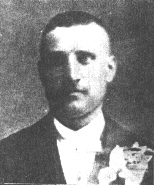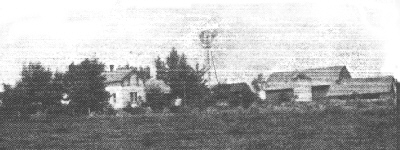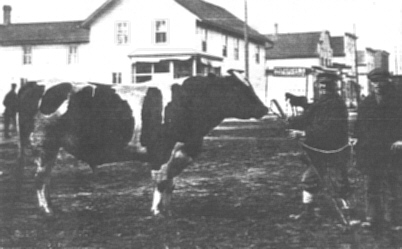The Biography of Felix A. Mikolainis
Contributed by Don Mikolainis

Felix A. Mikolainis (Feliksas Antonas Mikolainis) or like he himself wrote it (ANTON F. MIKOLAINIS OR F. MIKOLAINIS) was born January 17, 1866. Because there are different spellings of his name, for the rest of this history, his name will be spelled and referred to as FELIX A. MIKOLAINIS, as it is spelled on his gravestone.
He was born in the town of Ciziskiu, Vistyciu Parish, Suvalkijoye County in Lithuania.
As the saying goes, his education began at mother's university, sitting on a stool or kneeling alongside his mother where he learned his prayers and also to read the prayer book. Had a desire for learning on his own.
His eagerness for learning also enabled him to learn to speak, read, and write fluently in Polish and Russian in addition to his native Lithuanian language. In America, he self-taught himself to read and speak the American Language.
Around 1930, Felix wrote his autobiography. this autobiography to supplement this history capital letters and boldface printing. References are written to in capital letters and boldface printing.
IN HIS AUTOBIOGRAPHY: HIS SCHOOL IS MOTHERS SCHOOL, MOTHER WERE [WAS] SPINNING AND SHOWED HOW TO READ[,] HE SETS [SITS] ON ANY BLOCK OR STOOL, AND LEARNED [TO] READ ON PRAYER BOOK.
Coming to America just short of his 20th birthday in the year 1886. As per Hamburg's steamship passenger list: Ship's name Rhaetiar departed Hamburg, Germany, under the German flag on May 30, 1886. The captain's name was Fogelgwairg.
He stopped in Pennsylvania to work in the coal mines but did not like that type of work; so after a month, he headed for Chicago. He entered St. Francis Polish Monastery in Detroit, Michigan as a novice. He and another Lithuanian novice conversed in Lithuanian language. The superior requested that only the Polish language be spoken. Not willing to formal. his native tongue or nationality, Mikolainis left the monastery.
FIRST WORK, WAS COAL MINES, SHAMOKIN, PA, WORKED JUST ONE MONTH, CAME TO CHICAGO SAME YEAR [...]
In 1893 in Chicago, Illinois, while making his home at 754 West 17th Street, he became acquainted with a Polish woman and at the age of 27, Felix married Mary Holec, daughter of Michael Holec and Mary Kumeta from Bydgoscz, Poland.
Through research, other references of Mary Holec included Maryona, Maria, Maryanne, and Marianna. They were married at Providence of God Church, 17th and Halstad, Chicago, Illinois. Mary was born in 1866 in Poland. Felix and Mary entered a pre- nuptial agreement that she would learn the Lithuanian language and children of this union would also learn the language. When living in Chicago area, Felix was active in varies Lithuanian organizations, especially St. George's Society. He became an naturalized, American citizen on September 20, 1894, but remained a loyal Lithuanian patriot. During the "Depression of 1893", Felix "rode the rails" to work the flourishing lumber camps in the Thorp, Wisconsin, area. Before leaving P. Borden Plant in Chicago where he worked, he was given 5 cents by a man who told him to buy the biggest can of beer for himself as perhaps there would be no chance to buy beer in the woods.
In 1894, work was very hard to find in Chicago, so he decided to seek employment in the lumber camps of north central Wisconsin, having heard that some Lithuanian men were employed there. With $12.50 in his pocket he started to walk, and when luck smiled on him he rode -,-he freight trains; reaching Thorp, Wisconsin, after a few days, a distance of about 360 miles.
IN 1894, WAS HARD YEAR FOR WORKERS, ALL SUMMER WAS IDEL [IDLE], IN OCTOBER 1894 WENT ON FARM (WOODS) HE GONE FOOT FROM CHICAGO TO THORP, WISCONSIN, ON RAILROAD, CHANGE [CHANCE] ON FREIGHT TRAIN, HAVING $12.50 IN HIS POCKET. BUILT LITTLE LOG HOUSE, THEN HIS WIFE CAME WITH $2.50 AND THEY STARD [STARTED] FARMING IN THE WOODS, IT IS EASY FOR MAN OR WOMAN WITH ENERGIE [ENERGY].
[... ] HE DISLIKED CITY, AND BOUGHT 60 ACRES HEAVY WOODED LAND, ON PAYMENTS IN WISCONSIN WHEN HE WAS 27 YEARS OLD[.]
Settling in the Thorp area, he worked in the lumber camps and when he saved some money, he bought 40 acres of land located 3 miles east and two miles north of Thorp. That legal description was SE-1/4 of SE-1/4, Section 16, Town 29 North, Range 3 West, which he purchased April 2, 1896, from Charles and Jennie Burnham, John Burnham DS.(-'), and Ellen Rodgers for $400.

The Homestead of Felix & Mary Mikolainis in 1910
He built a small log cabin and sent for his wife who arrived by train with $2.50. Felix and his wife, Mary, endured many harsh years. During the day, he worked in the lumber camps and after his day's work he pulled out stumps and cleared the land for farming. Mary carded wool, spun, yarn, and knit mittens and socks which she sold to the camp workers.
Later he purchased an additional 20 acres from Northwestern Lumber Co. at the cost of $160. That legal description was E-1/2 of SW-1/4 of SE-1/4, Section 16, Town 29 North, Range 3 West.
This purchase made his farm a total of 60 acres at this point.

Felix & Mary's Farm in Rural Thorp, Wisconsin in 1933
HE WAS FIRST IN THE COMMUNYTY [COMMUNITY] TO BUILD SILO AND STARDED [STARTED] PURE BLOOD HOLSTEIN CATTLE, ... HE SAVE HIS CHILDREN EDUCATION ALL THEY LIKE, HIGH SCHOOL AND NORMAL SCHOOL.
As promised to Felix, Mary learned the Lithuanian language as did the children of this union. Felix was one of the first settlers in the area and the first Lithuanian national to start a farm. Shortly thereafter, other settlers came to buy cut-over land for farming. They were Lithuanian, Polish, Russian, and Ukrainian ethnic groups. Most of them were peasants, wanting a better life then than the people of their native countries.
Being one of the first settlers in the community who could read and write Lithuanian, Polish, Russian, and English, he was looked upon as a leader of the community and many sought his advice and services. He served as town chairman for two years, assessor for three years, and school district clerk for 27 years of Sunny Lawn School. He also served on a jury and was a justice of the peace for a few years. He was very much interested in education and convinced the county board to erect schools in the area so children would not have to walk more then two miles to any school; there were very few roads at that time so the children had to walk through woods and swamps. His pride was being a good American-Lithuanian citizen and grateful to America for freedom and opportunity to make a living in spite of many hardships in earlier years.
|
Felix with his prize bull and friend Tony Walterraites in dowtown Thorp, Wisconsin in 1930 |
CONSIDERING HIS EDUCATION (MOTHER SCHOOL) HE WAS CHAIRMAN 2 TERMS, ASSESSOR 3 TERMS, AND TOWN CLERK 2 TERMS[,] SCHOOL DISTRICT CLERK 27 YEARS, JUSTICE OF PEACE 1. TERM [,] ALLSO [ALSO] CROP REPERTER [REPORTER] 15 YEARS, HE SCHOOLED HIMSELF BY READING EVERYTHING, WRITES IN FOUR LANGUAGES[.]
Mary died of heart trouble, November 20, 1936, and was buried at St. Hedwig's Cemetery. On May 30, 1937, Felix suffered a paralytic stroke and died June 1, 1937, at his home. Funeral arrangements were made by Bogumill Funeral Home in Thorp and he was buried behind his wife at St. Hedwig's Cemetery located near the old church two miles east of Thorp. Pallbearers were George Zukowski, Louis Malecki, Anton Sololesk,i, George Jackowicz, Felix Mroz, Martin Pszesmicki. The family doctor was F. P. Neis of Thorp.
HE ALWAYS REMEMBER, ONE TIME HE SOWED RYE CANT DRAG IN DAYTIME, DRAGGED WITH A LANTERN, AND CUT CORN WITH MOONSHINE TILL 9 0 CLOCK P.M.
NOW HE IS 64 YEARS OLD. THE OLD DAYS BOTHER HIM, ENDHW [ANYHOW] EVRITHING [EVERYTHING] FOR HIS LAST DAYS, HE ALWAYS SAY GOD BLESS WASHINGTON'S LAND.
The Mikolainis family belonged to St. Hedwig's Catholic Church. For a while they left this church to form their own independent church located two miles east of St. Hedwig's Church. The land belonged to the Hoffman family. As they had no pastor, Felix Mikolainis was one who led the "worship service".
On May 30, 1897, they officially became known as an Independent Church using the names "All Saints Roman Catholic Church" and later "All Saints Independent Church". Officers of the church were: President--Philip Jasimski, Secretary--John Kurtinsitis, Treasurer--Felix Mikolainis.
Many of these people were of Lithuanian heritage. As quoted in the April 26, 1900, edition of The Thorp Courier, a celebration in honor of an ancient personage names Pusias who preached to Lithuanians over 2,000 years ago was held at the home of Felix Mikolainis in the Town of Withee on Sunday last. Speeches, declamations, dancing, singing, and a social dinner was the order and enjoyed by all present.
By 1909 many of these people returned to St. Hedwig's parish.
Following is a description of the buildings on the farm. The exact date when the log house was built is not known, but it was added on to in 1913. The barn was built in 1908, one of the first in the area and the silo was added in 1915. The old part of the barn located on the east side was torn off in 1926. The stone pig pen was built by a carpenter in 1916 or 1917.
The farm's address was Rural Route #4 but later was changed to Route #1, Box 108. The area was known as Neiman's Corner because Mrs. Neiman reported the news to ti@-e Thorp Courier, the local newspaper.
Felix and Marianna had nine children, five of whom died in infancy. Those who survived were: Kestutis, Sediminas, Milda, and Birute, and they spoke the Lithuanian and Polish languages. Kase (Kettutis), who was named after a Lithuanian king, was born July 30, 1899. On September 1, 1935, he married Sophie Rogus. Two children, Donald Jerome and Jolanta Dorothy, were born to the couple.
Mildred (Milda) was born in 1904. She attended Thorp High School, later moved to Cicero, Illinois, to work for Sears, Roebuck and Co. She lived at 2630 North Fairfield, l323 South 49th Court, and 1326 South 49th Avenue, Cicero, Illinois.
Sedmon Stanley (Sediminas) was born October 15, 1906, on his parent's farm near Thorp. He was confirmed by the Rev. A. J. McGavich, Bishop of LaCrosse, Wisconsin, St. Hedwig's Church, May 30, 1923, at the age of 18.
He attended high school for one year in Thorp and lived with a family in town. He lived on a the farm until he went to Cicero, Illinois, to become a meat cutter. He went into business with Peter Slozis, Sr., but then sold out to Mr. Grigas and worked for him for $25 per week He also worked at a factory, American Flange Co., for one year. Bertha (Birute) was born on December 27, 1908 on her fathers farm in the Town of Withee, Thorp, Wisconsin. After attending grade schools and Graduating from Thorp High school in 1927. She left Thorp for the city and got a job in 1928.
Felix A. Mikolainis
(Feliksas Antanas Mikolainis)
A short biography by Dr. G. I. Blozis which appeared in a Lithuanian newspaper in Chicago in 1937 and comments by daughter, Bertha Mikolainis.
Feliks A. Mikolainis (Feliksas Antanas Mikolainis) was born January 17, 1866, and died June 1, 1937. He was born in the Town of Ciolskiu, Vistyciu Parish, Suvalkijoje County, in Lithuania.
As the saying goes, his education began at "mother's University", -- sitting on a stool or kneeling alongside his mother where he learned his players and also to read the prayer book. A desire for learning on his own, enabled him to learn to speak, read, and write quite fluently in Polish and Russian in additional to his native Lithuanian language. ++(In America, he se2f-taught himself to read and write and speak the American language.)++
Coming to America just short of his twentieth birthday in the year 1886, he stopped in Pennsv2vania to work in the coal mines but did not like that type of work; so after a month, he headed for Chicago. He entered St. Francis Polish monastery as a novice. There, he and another Lithuanian novice conversed in the Lithuanian language. The superior required that only the Polish language be spoken. Not willing to forsake his native tongue or nationality, Mikolainis left the monastery.
When living in the Chicago area, he was active in various Lithuanian organizations, especially St. George's Society. He became an American citizen but remained a loyal Lithuanian patriot.
While making his home at 754 West Seventeenth Street, Chicago, Ill., he became acquainted with a Polish woman, Maria Holec, whom he married, with a pre-nuptial agreement that she would learn the Lithuanian language and children of this union were to be taught the language and children of this union were to be taught the language. As promised, Maria learned the language and the children of this union -- Keistutis, Gediminas, M!2da, and Birute -- spoke the Lithuanian and Polish languages.
In the year of 1894, work was very hard to find in Chicago, so he decided to seek employment in the lumber Camps Of North Central Wisconsin, having heard that some Lithuanian men were employed there. with in his pocket, he started to walk and when luck smiled on him, he rode the freight trains -- Teaching Thorp., Wisconsin, after several days -- a distance of about 360 miles.
Before leaving P. Borden plant in Chicago where he worked, he was given 5 cents by a man who asked him to buy the biggest can of beer for himself as perhaps there would be no chance to buy beer in the woods.
Settling, in the Thorp area, he worked in the lumber camps and when he saved some money, he bought 40 acres of land, paving $10.00 per acre. A new life was started here. He built a small log cabin and sent for his wife who arrived by train with $.50.
Mikolainis and his wife endured many harsh years. During the day, he worked in the lumbering camps and after his day's work, he pulled out stumps and cleared the land for farming. ++(My mother carded wool, spun year, and knit mittens and socks which were sold to the camp workers.)++
Mikolainis was one the first settlers in the areas to start a farm ++(Shortly afterwards, other settlers came to buy the out-over land for farming. They were Lithuanian, Polish, Russian , and Ukrainian ethnic groups. Most of them were peasants, wanting to better life than that of their native countries.
Mikolainis, being one of the first settlers in the community who could read and write in Lithuanian, Polish, and American, he was looked upon as a leader of the community and many sought his advice services. He served as town chairman for two years and as assessor for three years; as a school district clerk for 27 years. He was very much interested in education and convinced the county board to erect schools in the area so children would not have to walk more than two miles to any school; there were very few roads at that time so the children had to walk through woods and swamps.)++ He also served on a jury and was a justice of peace for a few years.
His pride was being a good American-Lithuanian citizen and grateful to America for freedom and opportunity to make a living in spite of many hardships in earlier years.
He died June 1, 1937, and is buried in St. Hedwig's old cemetery, next to his wife who died six months earlier. Autobiography by Dr. G. I. Blozis. a friend of the family. This biography appears in a Lithuanian newspaper in Chicago, on June 17, 1937, Special thanks to the following people who graciously translated the Lithuanian biography. Mrs. Anne Gehrke, Owen, Wisconsin, Translator Albin Kurtinaitis, Owen, Wisconsin, Translator .Mrs. Mary Monsen for edited version Further edited by B. Mikolainis. Retyped and edited by D. Mikolainis Anne Gehrke is a sister-in-law of Gedman Mikolainis. Albin Kurtinaltis was a good friend of the family. Mary Monsen is a cousin of Anne Gehrke.
**This Clark Co., WI Internet Library, ALHN & AHGP website is dedicated to the free sharing of information by researchers, local historians, genealogists and educators. Because of our non-profit status, submissions are not to be used for profiteering of any kind. Our representatives cannot accept gratuities beyond the basic expenses (i.e. postage, copying, courthouse or rental fees) for obtaining requested information. We reserve the right to ban the involvement of anyone who intentionally disregards these policies. Please show your appreciation for this database by Becoming a Clark County History Buff or making a contribution to our Support Fund and Perpetual Preservation Account to help keep this Clark Co., WI database freely available on the World Wide Web and free from commercial enterprise.
*** This copyrighted Clark Co., Wis. genealogy and history material is used by permission of the submitters. Contact us if anyone is using this data inappropriately. It may not be copied and posted to any commercial/.com genealogy sites such as Genealogy Trails, Family Tree Maker or the merged companies Ancestry.Com/RootsWeb/MyFamily or sold for profit.
This page is a part of the Clark County, WI Internet Library Project
Every submission is protected by the Digital Millennium Copyright Act of 1998.
~~The Clark Co., Wisconsin History Buffs maintain these pages in support of Free On-line History & Genealogy~~
